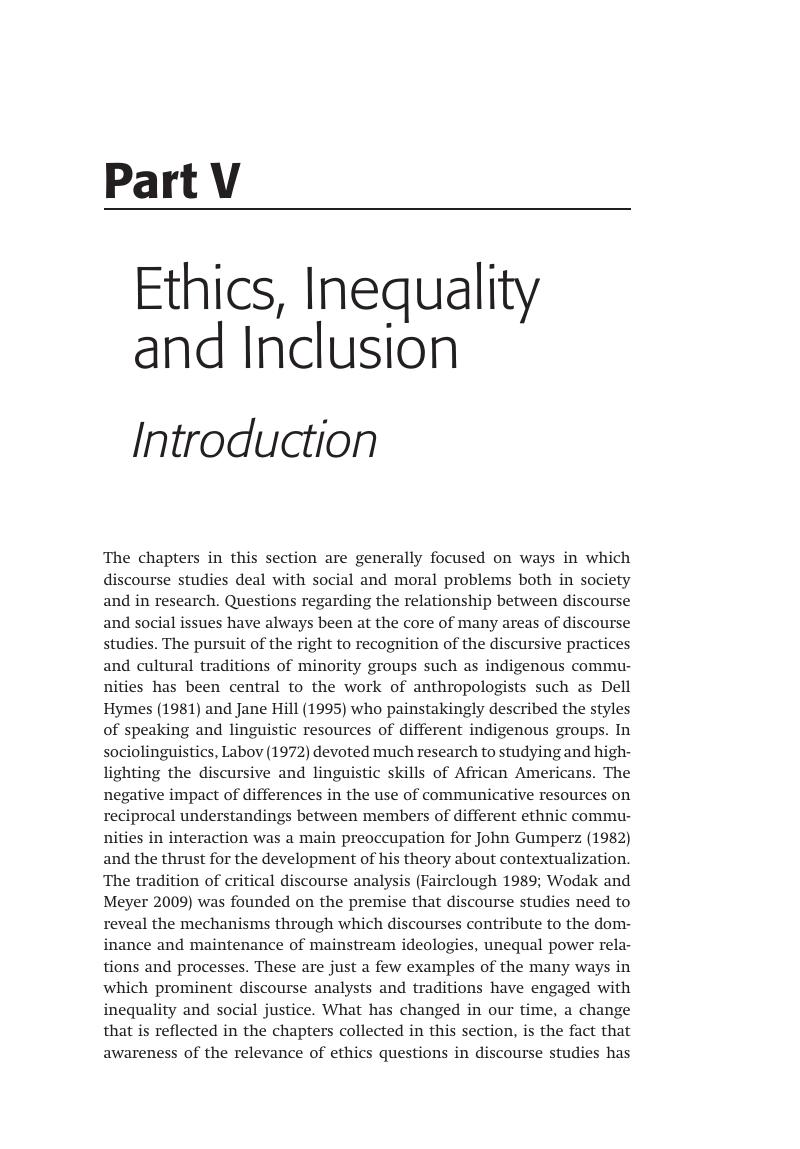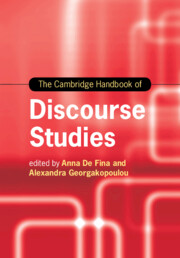Book contents
- The Cambridge Handbook of Discourse Studies
- Cambridge Handbooks in Language and Linguistics
- The Cambridge Handbook of Discourse Studies
- Copyright page
- Contents
- Figures
- Tables
- Contributors
- Preface
- Part I (Con)Textualizing Discourses
- Part II Perspectives and Modes of Analysis
- Part III Discourse Materialities and Embodiment
- Part IV (Trans)Locations and Intersections
- Part V Ethics, Inequality and Inclusion
- Part VI Discourses, Publics and Mediatization
- Index
- References
Part V - Ethics, Inequality and Inclusion
Introduction
Published online by Cambridge University Press: 28 September 2020
- The Cambridge Handbook of Discourse Studies
- Cambridge Handbooks in Language and Linguistics
- The Cambridge Handbook of Discourse Studies
- Copyright page
- Contents
- Figures
- Tables
- Contributors
- Preface
- Part I (Con)Textualizing Discourses
- Part II Perspectives and Modes of Analysis
- Part III Discourse Materialities and Embodiment
- Part IV (Trans)Locations and Intersections
- Part V Ethics, Inequality and Inclusion
- Part VI Discourses, Publics and Mediatization
- Index
- References
Summary

- Type
- Chapter
- Information
- The Cambridge Handbook of Discourse Studies , pp. 457 - 592Publisher: Cambridge University PressPrint publication year: 2020
References
References
Further Reading
This is perhaps the most useful set of ethical guidelines for the field of discourse studies; it provides comprehensive and helpful coverage of the issues.
This is a seminal work which takes a very different stance from that adopted in this chapter. Several chapters provide illuminating insights into concrete ethical problems.
This handbook examines ethical dilemmas via discussion of a wide variety of actual cases; it is designed for teaching anthropology students but is of wider value.
This is a thoughtful and helpful discussion of ethical issues specifically relating to linguistic fieldwork.
This general account of research ethics, in the context of qualitative research, elaborates on the arguments presented in this chapter.
This recent handbook contains thirty-five chapters discussing a wide range of ethical issues that can arise in carrying out qualitative research.
A useful discussion of a range of ethical debates relating to applied linguistics.
This is a review of issues arising in qualitative research in the field of applied linguistics and of some of the contrasting views taken about them.
References
Further Reading
This book addresses the complex question of how inclusivity and diversity can be fostered in a democracy. It proposes a model of public deliberation based on the public reasoning and discussions of citizens so as to encourage cooperation amidst increased social complexity.
This volume elaborates on the notion of linguistic citizenship, presenting studies from the global South. It shows how addressing speakers’ vulnerability and need to exercise agency requires first deconstructing ideas of what language is.
This volume highlights the importance of approaching the language–citizenship nexus from a multivocal, multimodal and semiotic perspective. Drawn from a variety of case studies, it shows how conflicting notions of citizenship can be understood only if institutional discourses are combined with more ethnographic data.
References
Further Reading
To further learn about how different discourse approaches applied to critically examine diversity and inclusion in educational contexts, how locally situated practices and identity shape and are shaped by broader institutional or sociopolitical ideologies, and the relationships between researcher and the researched, we recommend the following three books:
Bucholtz examines how white teenage students use their linguistic resources (e.g., Valley Girl speech, African American English) to demonstrate identities based on race and youth cultures, and to position themselves and others in accordance with the school’s racialized social order.
This edited book discusses multilingualism and discourse from different sociolinguistic and/or ethnographic perspectives, reviews conceptual and methodological concerns and challenges that researchers face, and suggests future directions in the relevant fields.
This edited book provides an introduction to critical discourse analysis, reviewing various theories and methods associated within the fields of applied linguistics and linguistic anthropology. It also examines how critical discourse analysis, as a theory and method, is applied to the research of diversity, exclusion and inclusion in educational and societal contexts.
References
Further Reading
In this multi-authored work, Alim, Rickford and Ball introduce the concept of raciolinguistics, or how language and ideas about race intersect. In three sections, “Languaging Race,” “Racing Language” and “Language, Race, and Education in Changing Communities,” researchers from several global contexts offer new perspectives on racialization, racial malleability and marginalization, among other topics addressing race and discourse.
Back and Zavala situate Peruvian ideas about race and racialization in the overall context of Latin American scholarship on race. Each empirical study in this multi-authored work offers a unique glimpse into the complex construction of racialized identities and “race talk” in both real-world and virtual contexts.
This excellent chapter proposes three main approaches in the study of language, race and ideology: the distinctive ethnoracial language, the acts of ethnoracial identity and the racialization approach. It discusses critical issues for addressing the key role of language in semiotic processes of racialization.
This article establishes the research agenda of a raciolinguistics perspective after the groundbreaking article from Flores and Rosa (2015, see references). It theorizes the historical and contemporary co-naturalization of language and race and discusses five key components of this perspective.
In this book, the author discusses how racial ideas and structural racism permeate the lives of shantytown youth and people from the middle class in Rio de Janeiro, Brazil. She argues that the amount of whiteness or blackness a body displays is determined not only through observations of phenotypical features but also through attention paid to always malleable cultural and linguistic practices.
References
Further Reading
This volume provides global perspectives on the laws and policies of political asylum.
This volume remains a foundational study on the ways in which narratives function in legal settings.
This is an important study of the gendered dimension of asylum.
References
Further Reading
This is the Position Paper for the Perspectives followed by five commentaries.
This is an ethnographic exploration of the intersection of ELT and evangelical Christianity in the context of an English language school with a Bible-based curriculum in Poland.
This edited collection investigates how children and adolescents leverage rich and complex multilingual, multiscriptal and multimodal resources associated with religion for meaning-making and the performance of religious subjectivities in homes, religious education classes, faith-inspired schools and places of worship across a range of religious communities.

